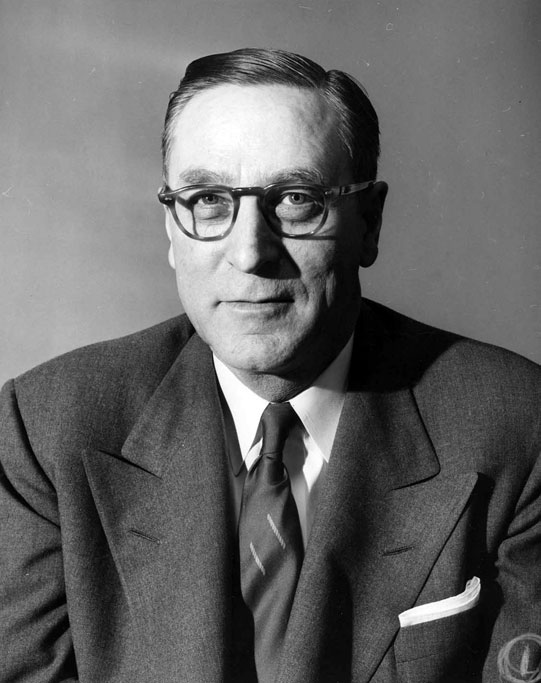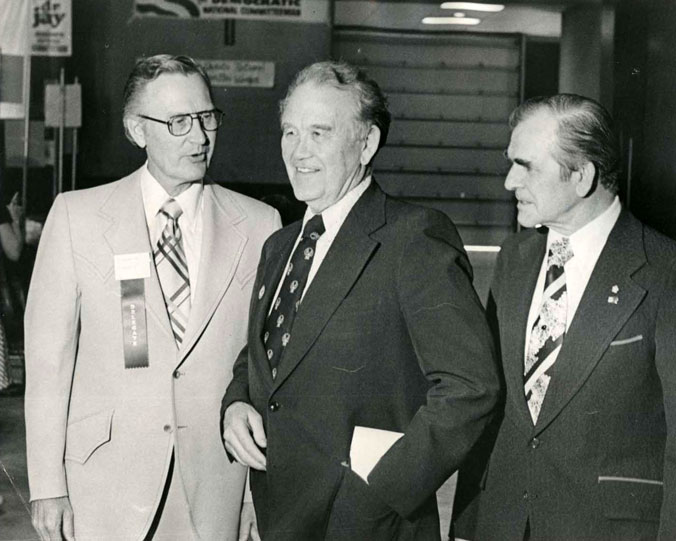We’ve launched a new web portal! Visit findhistory.nd.gov to search our collections.
Due to a road closure, the Killdeer Mountain Battlefield State Historic Site is temporarily closed.

Even as the state modernized, established political patterns continued. A new insurgency, the Republican Organizing Committee (ROC), quickly became powerful after 1943. It elected Fred Aandahl as Governor in 1944 and controlled the office until the late 1950s. Its leaders included Milton R. Young, who was selected to fill the Senate seat vacated by the death of John Moses in 1945 and served until 1981. ROC success forced realignment in state politics; to unite liberals under one banner, the Nonpartisan League and the Democratic Party moved toward consolidation in the 1950s finally agreeing to run a unified ticket in 1956 and eventually merging in 1960. The Democratic-NPL obtained some immediate success; in 1958, well-known liberal leader Quentin N. Burdick became North Dakota's first Democratic congressman, and in 1960 the party gained the Governor's office and held it continuously for the next twenty years, including four consecutive victories by William L. Guy (1961-1973) and two by Arthur A. Link (1973-1981).

In the 1980s, political control of the state has shifted between the two parties. Republican Allen I. Olson upset incumbent Governor Link in 1980; the election put many Republicans into state office and in part resulted from the overwhelming popularity of Presidential hopeful Ronald Reagan. Within two years, however, Democratic-NPL efforts to regain the party's momentum resulted in steady gains, and in 1984 Olson's bid for re-election was stymied by Casselton farmer George A. Sinner. In 1986, Democrats for the first time won control of the State Senate, as well. After a century of domination by the Republican Party, North Dakota now has a vibrant two-party politics.
The major issues of the 1970s and 1980s have been modern incarnations of longtime debates. One important issue has been economic development, and once again the discussions have centered on the creation of a climate favorable to capital investment in the state. A struggling farm economy has brought many changes to the state, and demands for improved state services for people with special needs have forced major reallocation of available tax dollars. The basic issue has been determining the proper uses for limited tax resources and the most productive ways to stimulate economic development.
Address:
612 East Boulevard Ave.
Bismarck, North Dakota 58505
Get Directions
Hours:
State Museum and Store: 8 a.m. - 5 p.m. M-F; Sat. & Sun. 10 a.m. - 5 p.m.
We are closed New Year's Day, Easter, Thanksgiving Day, and Christmas Day. We are closed at noon Christmas Eve if it falls on Mon.-Thurs. and are closed all day if it falls on Fri.-Sun.
State Archives: 8 a.m. - 4:30 p.m. M-F, except state holidays; 2nd Sat. of each month, 10 a.m. - 4:30 p.m. Appointments are recommended. To schedule an appointment, please contact us at 701.328.2091 or archives@nd.gov.
State Historical Society offices: 8 a.m. - 5 p.m. M-F, except state holidays.
Contact Us:
phone: 701.328.2666
email: history@nd.gov
Social Media:
See all social media accounts